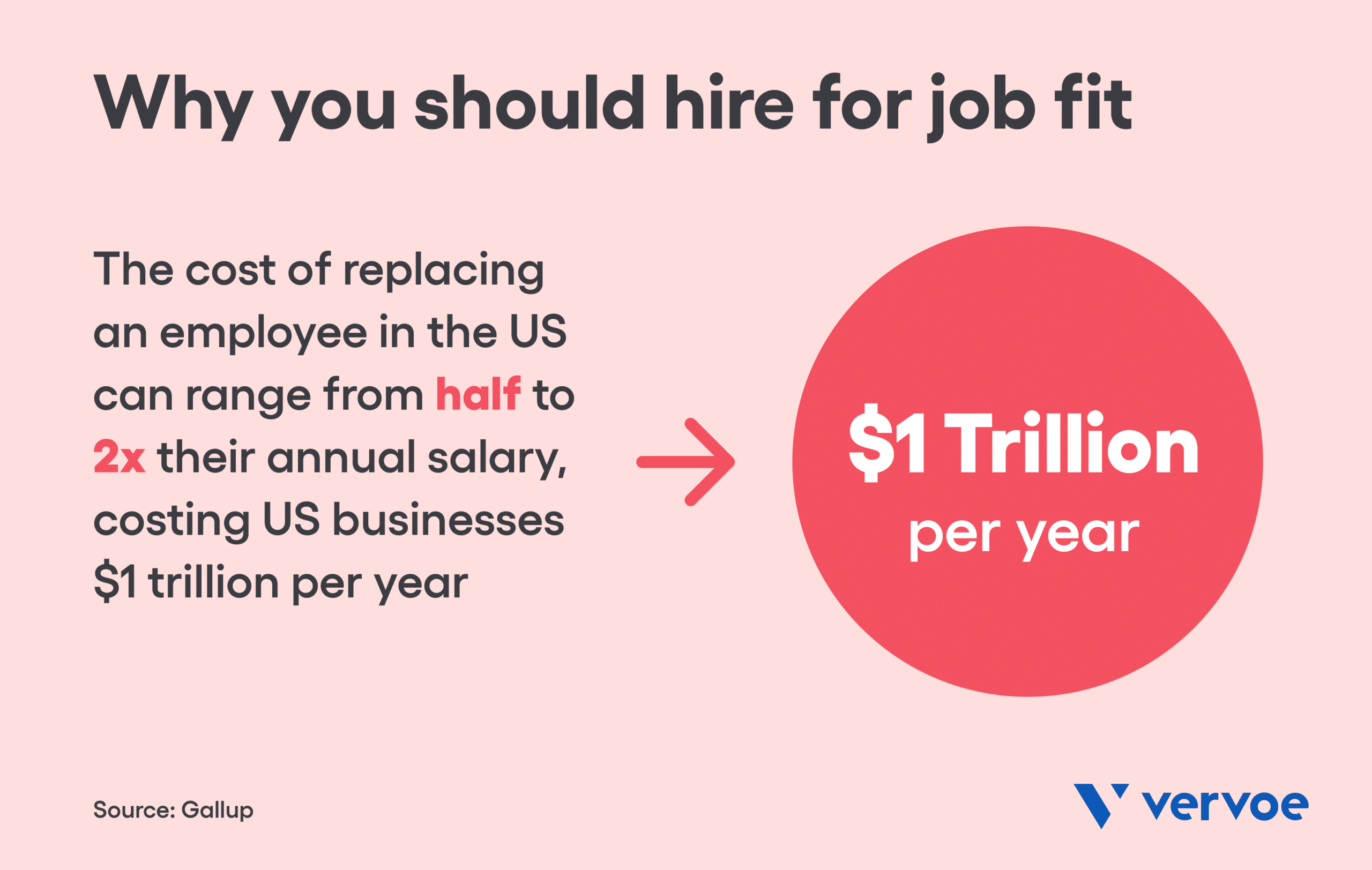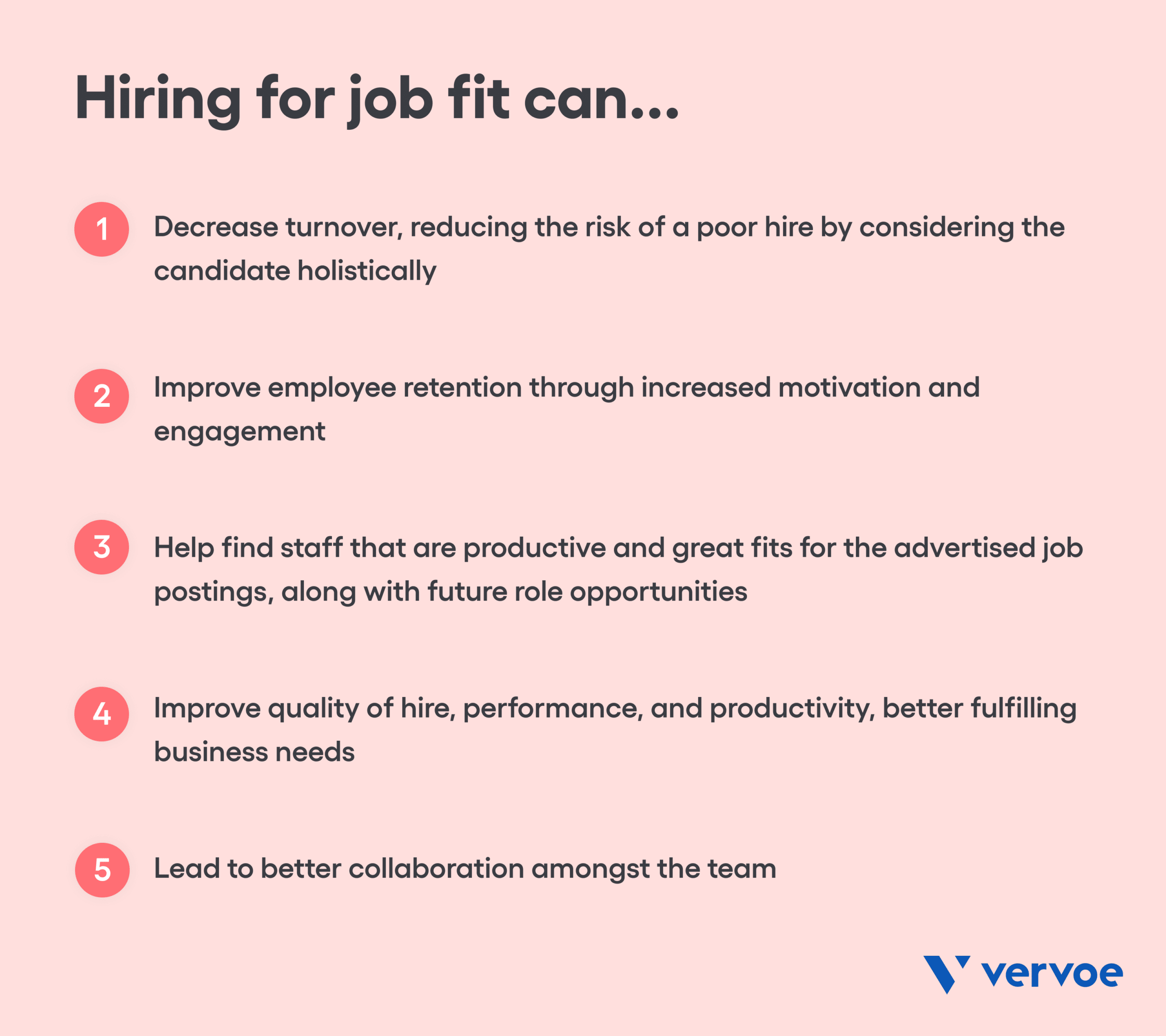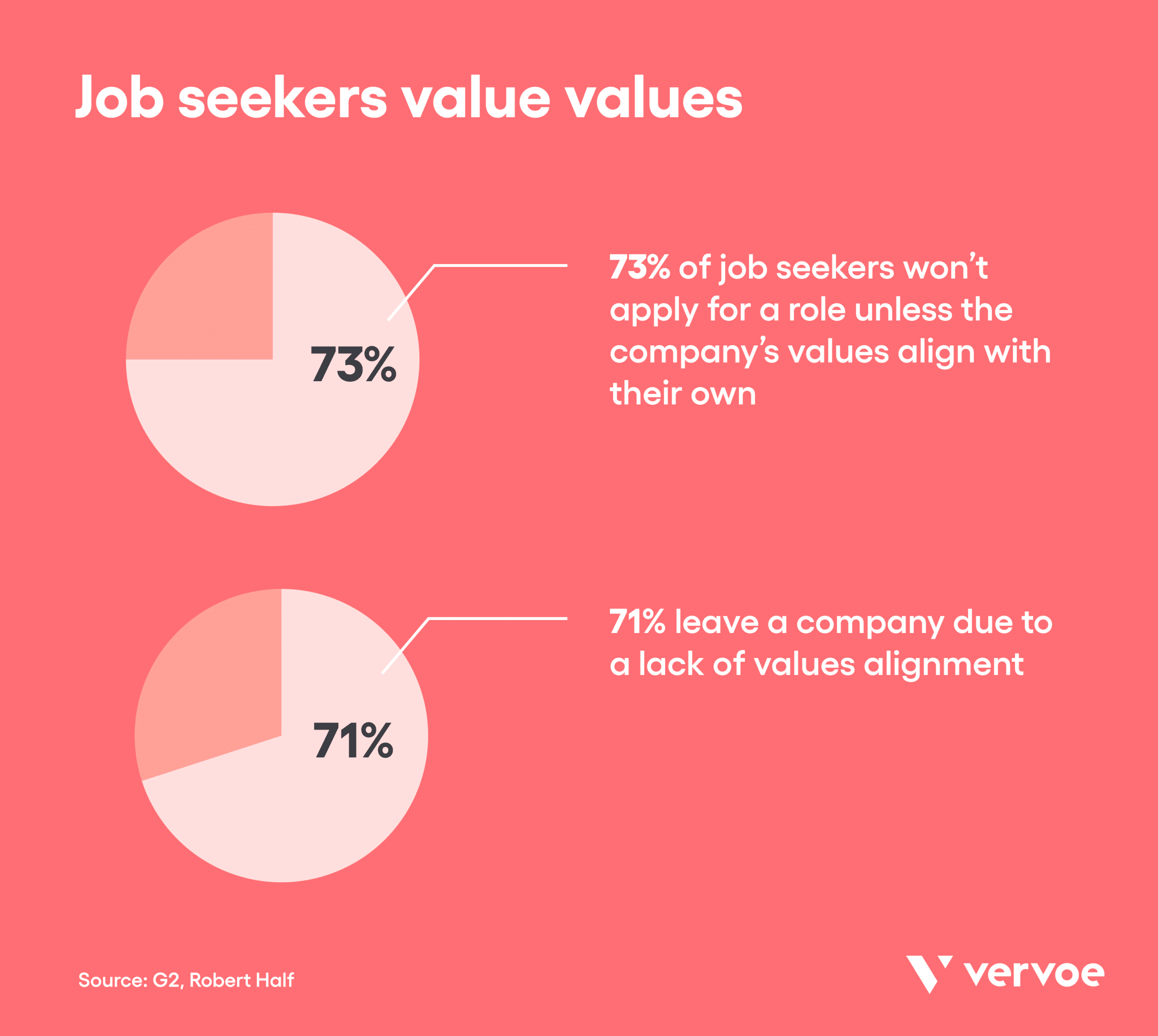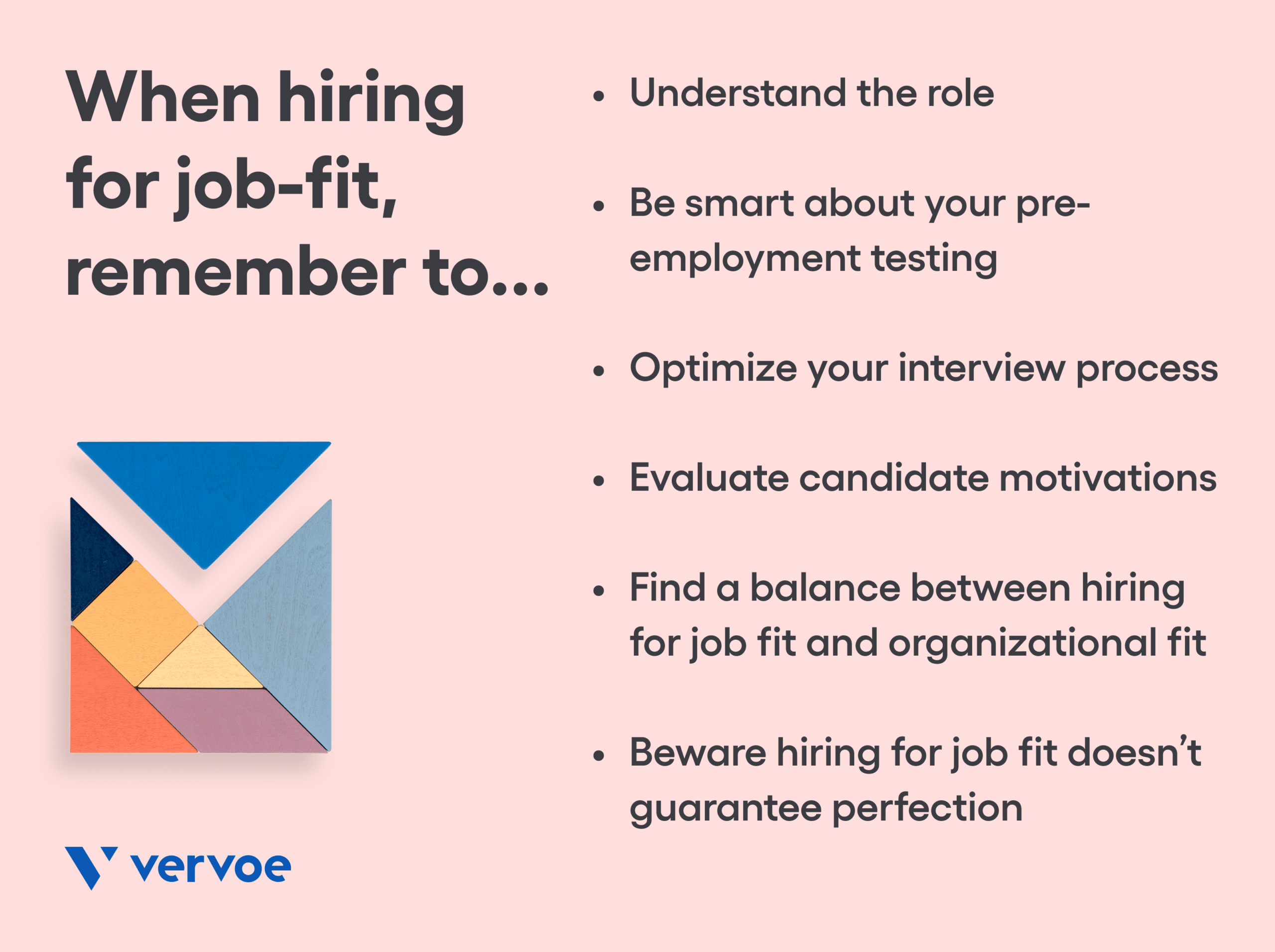Consider this: you’ve conducted a rigorous hiring process and made what you thought was a great hire. Kim is an excellent data analyst and – on paper – ticks all the boxes. She’s fast, accurate, proficient with technology … yet, after doing a job fit assessment, it’s becoming increasingly clear that Kim isn’t a great fit for the role.
You speak with Kim’s hiring manager and ask to hear more about the recruitment process to discover what went wrong. It turns out that while she can’t be faulted for her analytical work, she’s struggling with the other, subtler requirements of the job.
Kim doesn’t communicate or collaborate well with the rest of the team, isn’t great with clients, and doesn’t quite fit in with the organization and culture.
More importantly, her manager can’t envisage Kim stepping up if a promotion becomes available in the future, or ultimately trust her to do her job without guidance.
Somehow, you’ve hired a person who is great at the technical aspects of her job, yet isn’t a great fit for the role. How could this have been avoided?
Introducing job fit
Hiring a talented person as a new employee and hiring for job fit isn’t always the same thing.
We’ve written previously about organizational fit and cultural fit. Job fit is another important consideration when hiring. It pushes you to develop a better understanding of what the candidate needs to fill the job requirements, whether they’ll be a good fit in your work environment, what a good job fit looks like, and what job fit assessments you can use to make a hiring decision.
In this article, we introduce the concept of the job fit assessment and provide a framework for assessing candidates’ job suitability.
What is a job fit?
A holistic concept in hiring, job fit measures not only the abilities a candidate requires to succeed in a role but their potential to bond with colleagues and solve problems in the work environment. The term encompasses hard skills, soft skills, values, and cultural fit.
Examples of a poor job fit could include:
- An excellent coder who cannot collaborate effectively with the rest of the team
- A highly collaborative teammate who lacks the hard skills required to write effective code
- A member of the leadership team whose values don’t align with the values of the wider business
Why does job fit matter?
Why should employers take so many factors into account when hiring? Because a top-performing employee who isn’t a good cultural and organizational fit will be dissatisfied at work, lack motivation, and will be more likely to leave. On the flip side, someone who integrates well with the culture but doesn’t possess the right technical skills will struggle at work, impact overall performance and not be the best fit.
Candidates should consider job fit when applying for roles to avoid disappointment. For example, an engineer may have the perfect technical background for a role in the oil and gas industry. But if their values do not match those of their employer, they will soon become disengaged and begin to seek employment elsewhere.
The medical profession provides a great example of the importance of assessing applicants for both hard and soft skill sets. While doctors must possess plenty of academic ability and technical knowledge, they cannot work effectively without empathy, communication, and a good bedside manner.
The clinical skills test in the US conducts pre-employment assessments on medical students’ soft skills, including their ability to communicate clearly with patients and listen intently without interrupting.
Benefits of hiring for job fit
According to Gallup, the cost of replacing an employee in the US can range from one-half to two times their annual salary and costs US businesses one trillion dollars per year in total. Besides the financial impact, high turnover can lead to low morale, overworked employees, lower productivity, and a slip in quality.

Many of the reasons good employees leave their jobs – a lack of engagement, struggling to build relationships with managers, and burnout – can be avoided by hiring managers reassessing traditional assessments and analyzing employee job fit.
Leaving due to not getting along with a manager, for example, comes down to problems with skills like communication and relationship-building.
Hiring for job fit is a key way for organizations to reduce attrition. In addition, it can:
- Decrease turnover, reducing the risk of a poor hire by considering the candidate holistically
- Improve employee retention through increased motivation and engagement
- Help find staff that are productive and great fits for the advertised job postings, along with future role opportunities
- Improve quality of hire, performance, and productivity, better fulfilling business needs
- Lead to better collaboration amongst the team

Is perfect job fit an unrealistic goal?
Expecting applicants to possess the right hard skills that match the job responsibilities, excellent soft abilities, cultural fit, and values alignment can be a tad unrealistic and lead you to dismiss a good fit for someone perfect.
There is a danger that organizations seeking a “unicorn” candidate that ticks every box of the job requirements will limit their chances of making a good hire by setting the bar too high.
Instead of expecting applicants to achieve a perfect score in every area, a better approach is to be alert for red flags.
For example, while your skills assessment may reveal a sales professional possesses excellent people skills, behavioral questions may indicate that their values and the company’s are significantly different. In this case, the salesperson’s ability to succeed and thrive in your business would be hampered by their values, meaning they would be a poor hire.
Job fit assessment
So, what are the factors that create an ideal job fit? Rather than hiring for positions based on a list of factors associated with the job, a job fit assessment should take the following into account.

Technical skills
Let’s start with the obvious: candidates require the right technical abilities for particular positions being advertised. Coders must be able to code, analysts must have analytical skills, marketers require written communication skills, and so on.
Use a skills assessment during your hiring process to assess job fit in terms of technical proficiency, but don’t rely on this alone. Determining a candidate’s job fit involves a 360-degree approach that uses interviews and other interactions to consider much more than technical ability.
Soft skills
A Wall Street Journal survey of 900 executives revealed that 92% believe soft skills are equally or more important than technical expertise. A job fit assessment should include soft skills like critical thinking, leadership, collaboration with others, influence, time management, and adaptability.

Cultural fit
Will the candidate integrate seamlessly into your existing culture? Cultural fit involves an alignment of behaviors, working styles, personality traits, and values between the candidate and the employer. However, employers should beware of an over-focus on cultural fit and its detrimental effect on diversity hiring.
Values
Values alignment is an inescapable factor when considering job fit and equally important in terms of talent attraction and retention. According to research collated by G2, 73% of job seekers won’t apply for a role unless the company’s values align with their own.
In the case of existing employees, 71% leave a company due to a lack of values alignment, according to Robert Half. As a result, human resources teams are increasingly incorporating values assessments into pre-employment assessments, along with psychometric tests.

Experience, education, and training
Does the candidate have the right experience, education, and training for the role? At Vervoe we strongly believe it’s a candidate’s skills that matter rather than where they went to college or where they’ve worked in the past.
But a candidate’s educational background and job pedigree is a factor for many employers when considering a candidate’s job fit.
Use a skills assessment to identify strengths that would mean a great job fit for the role, and provide further training for any identified skills gaps in a timely manner.
Things to be mindful of when hiring for job fit
Hiring for good job fit is a lot more than a box-ticking exercise. Here are some tips to keep in mind.

Understand the role
Increase your chances of excellent job fit by getting the job description right. Job postings should contain more than just a laundry list of technical skills; they should reflect a deep understanding of the role, the relationships it involves, and the soft and hard skills that will stand a candidate in good stead.
Job descriptions should provide as much detail as possible to help candidates and recruiters conduct their own job fit assessments – for example, it should have a values statement, describe the team culture, and describe the ideal candidate.
Be smart about your pre-employment testing
Don’t try to assess job fit through resume screening or through the interview process. The danger is that candidates will attempt to pass a good job fit assessment by simply regurgitating the requirements listed in the job post throughout the recruitment process.
A better approach is to test and validate the skills they claim to possess.
Use a skills assessment to test for each of the technical and soft skills identified in the job fit criteria. Vervoe’s assessment library includes tests for hard skills such as coding tasks, alongside soft ones like communication, collaboration, and cultural fit.
Optimize your interview process
Think about what interview questions you will need to ask shortlisted candidates in an interview scenario to determine current job fit. Standardize your interview questions, and consider using a scoring system to ensure fairness and reduce the likelihood of bias.
Ask behavioral questions to assess the candidate’s working style, values, cultural fit, and ability to form relationships. Glassdoor provides the following example of a behavioral question for assessing a candidates’ values and integrity:
“Describe a time when you were asked to perform a task or spearhead an initiative that went against your values. What did you do? What was the outcome?”
Evaluate candidates’ motivations
Evaluating a candidates’ motivations is an effective way to test job fit. Apart from earning a wage, why do they want to work for your business?
Testing for values alignment means discovering areas where a potential employee and business have motivating factor alignment, such as being motivated by improving sustainability or generating social outcomes.
Find a balance between hiring for job fit and organizational fit
Avoid taking the term “job fit” too literally. In other words, don’t make the mistake of hiring someone who would be an excellent fit for a particular position but a poor fit for any future opportunities. An example might be a software engineer who lacks the communication abilities they’d need to ever step up into a managerial position or client-facing role.
Take a long-term view by hiring someone with the technical skills that will help them succeed in the position you need to be filled, and the soft abilities that will take them a long way in your organization by putting them in line for future leadership roles.
Don’t confuse job fit for perfection
Remember, job fit does not mean only hiring candidates who perfectly meet every single criteria. So long as a candidate is a good match in terms of having the right skills for the job and displays an ability to form relationships in the organization, they should be considered for the role. Minor gaps identified through skills assessments can be addressed through training or mentoring.
The red flag to look out for is a deficiency in certain traits and abilities that would handicap their ability to thrive at your company, as experienced in the case of Kim at the beginning of this article.
Final thoughts
Nothing beats the power of evidence-based hiring for predicting future job success. Attempting to determine a fit job for someone through a resume review is the hard part because most candidates tweak their resumes to address each point in the job description.
Similarly, candidates in a job interview situation are likely to stretch the truth and tell you what you want to hear to convince you they’re a good match.
With the help of our AI-enhanced skills assessment technology, Vervoe has turned job fit assessment from an art into more of a science. Incorporating skills assessments into your hiring process will give you confidence your next hire matches the job fit criteria required to thrive in their position.
You’ll end up with an employee who’s more productive, has high motivation, fits into your work environment, and can successfully handle the tasks of a particular role well.
Reimagine your pre-employment assessments today, and start ensuring you hire a good fit for your business every time.




















